The former Municipal Office & Town Hall - a two-in-one public building
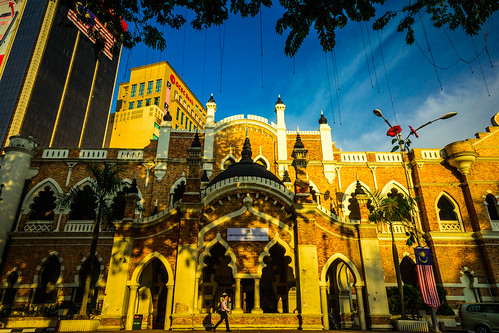 |
| The former Municipal Office & Town Hall |
At the turn of the last century the construction of government buildings was concentrated around the perimeter of the Padang (now the Merdeka Square) which Chen Voon Fee called the civic heart of Kuala Lumpur. The first ever grand public building built by the British colonial government was the Government Offices (later renamed the Sultan Abdul Samad Building) completed in 1897.
Upon completion of the Government Offices, its architecture has become the trend-setter to be followed by other public buildings erected along the perimeter of the Padang. The second public building designed in Indo-Saracenic architecture built by the colonial government was the Municipal Office & Town Hall. It was a two-in-one building accommodating the Kuala Lumpur Sanitary Board (the predecessor of Kuala Lumpur City Hall) offices and the Town Hall which was a venue for dances, plays and entertainment on stage for those belonging in high society.
The building's architecture was designed by AB Hubback in 1901. Hubback, a Federal PWD Architectural Assistant was also a member of the Kuala Lumpur Sanitary Board. The site chosen to build the new building was by the Gombak Bridge that spanned the Gombak River, a stone throw away from the then newly completed Government Offices (the Sultan Abdul Samad Building).
The British colonial government called for tenders in 1902 and the contract was eventually awarded to Messrs. W. Nicholas in August the same year. Although W. Nicholas started the work almost immediately upon winning the contract he was unfortunate in having to encounter many obstacles during the project.
The first challenge he had to face was an abnormally rainy season upon commencing the work which culminated in the famous November flood. This delayed the construction work as the earthwork has turned into a maze of canals.
When the fine weather came, further troubles followed - the contractor had to face an enormous price hike for the construction materials and this compelled him to produce his own bricks to save cost. Not only that, there was also an outbreak of rinderpest. The bullocks that he purchased earlier in Penang for carting purpose had to be placed in quarantine at Port Swettenham (now Port Klang) for nine weeks.
After going through all the troubles, matters improved without anymore hitch occurred until the fire in June 1904 when nearly all the woodwork for the interior of the building was destroyed.
The time fixed for the conclusion of the work was May 1904 but the contractor obtained two extensions for additional work ordered.
The Malay Mail dated 2 December 1904 reported:
The Municipal Offices were completed more than one month later though. In the Annual Report FMS Selangor 1904 it was stated that The new Municipal Offices in Kuala Lumpur, adjoining to the Town Hall, were occupied by the Sanitary Board staff on 27 October 1904. They were reported to be in every way suitable for the purpose for which they were designed.
Kuala Lumpur Sanitary Board was set up in 1890 whose members included heads of state departments, such as Medical, Public Works and Police, and also two Malay and two Chinese members of the State Council, men of influence. This was the first municipal body in any Malay state and became the general model. The Board first occupied a shophouse in Ampang Road at its office and in 1894 moved to another shophouse but bigger located at 137, Batu Road (now Jalan Tuanku Abdul Rahman) before it eventually was relocated to a proper office in its own building, The Municipal Office & Town Hall in 1904 as stated above.
The Malay Mail dated 2 December 1904 heaped praise on this elegant Indo-Saracenic edifice which was the second structure in that style after the Sultan Abdul Samad Building. The Malay Mail stated as follows:
With the completion of this building it was another achievement for the engineering team led by the State Engineer, CE Spooner, and the prolific architect, AB Hubback after their success in completing the Sultan Abdul Samad Building in 1897.
This building strongly features Indo-Saracenic architectural style such as their prominent bulbous domes that topped both porte cochère at its each entrance. While its arcade is adorned with pointed horse shoe arches and scallop arches. There is also an overhanging balcony which is a typical Mughal architectural feature from which Indo-Saracenic architecture resulted.
This historic building has been standing strong for close to 113 years. Until now it still serves as the City Theatre or Panggung Bandaraya in Malay where various plays and musicals are staged here.
However what still remains are only the outer structure and the façade after a major fire entirely destroyed the interior of both the former City Hall office and the City Theatre (Panggung Bandaraya in Malay) on 16 March 1992. The fire was reported to have spread fast because of the plywood and softboard ceilings and the lack of modern fire-fighting equipment in the building. But soon after, the City Hall's designers and builders have restored its interior by refurbishing it and incorporating significant modifications to the furnishings and the sound system.
The building is now known as Panggung Bandaraya (Malay for City Theatre) and is gazetted as a heritage building under the Antiquities Act (It is now replaced with National Heritage Act 2005), while its Mughal-eclectic/Indo-Saracenic façade has been preserved.
REFERENCE
Gullick, J.M. (2000). A history of Kuala Lumpur 1857-1939. Kuala Lumpur: MBRAS.
Mathews, P. (2014). Chronicle of Malaysia: Fifty years of headline news, 1963-2013. Singapore: Editions Didier Millet.
Our municipal offices and town hall. (1904, December 2). The Malay Mail.
Sir William Treacher. Grand farewell ball at Kuala Lumpur. (1904, September 10). The Straits Times, p.5.
The building's architecture was designed by AB Hubback in 1901. Hubback, a Federal PWD Architectural Assistant was also a member of the Kuala Lumpur Sanitary Board. The site chosen to build the new building was by the Gombak Bridge that spanned the Gombak River, a stone throw away from the then newly completed Government Offices (the Sultan Abdul Samad Building).
The British colonial government called for tenders in 1902 and the contract was eventually awarded to Messrs. W. Nicholas in August the same year. Although W. Nicholas started the work almost immediately upon winning the contract he was unfortunate in having to encounter many obstacles during the project.
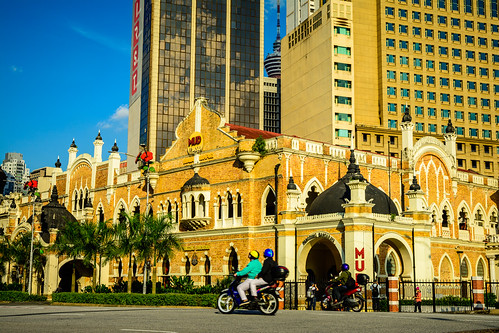 |
| Both of the domed porches at the entrance to the Municipal Office and Town Hall |
The first challenge he had to face was an abnormally rainy season upon commencing the work which culminated in the famous November flood. This delayed the construction work as the earthwork has turned into a maze of canals.
When the fine weather came, further troubles followed - the contractor had to face an enormous price hike for the construction materials and this compelled him to produce his own bricks to save cost. Not only that, there was also an outbreak of rinderpest. The bullocks that he purchased earlier in Penang for carting purpose had to be placed in quarantine at Port Swettenham (now Port Klang) for nine weeks.
After going through all the troubles, matters improved without anymore hitch occurred until the fire in June 1904 when nearly all the woodwork for the interior of the building was destroyed.
The time fixed for the conclusion of the work was May 1904 but the contractor obtained two extensions for additional work ordered.
 |
| One of the two entrances. This entrance fronts on to Jalan Raja. |
The Malay Mail dated 2 December 1904 reported:
The Town Hall was the first portion finished, as the Town Hall needed to be prepared to host the Grand Farewell Ball for the departing Resident-General, Sir William Treacher and his wife, Lady Treacher on 8 September 1904. The Hall measured 80ft x 4ft and 40ft high. On each side of it are verandahs 10ft in width.
At the far end is a stage 25ft x 45ft with wings and dressing-rooms, with lavatories attached. The entrance hall measures 4ftx30ft, including the cloak-rooms, and the upper hall is the same size.The Straits Times dated 10 September 1904 stated that on Thursday night (8 September 1904) the departing Resident-General, Sir William Treacher and Lady Treacher, were the guests at a grand farewell ball given in their honor by the people of Kuala Lumpur. The event was held at the spanking new Town Hall and it was reported that an extensive scheme of decorations added to the beauty of the new building. The occasion was a double barreled event - it was a grand farewell ball for the newly retired Resident General, Sir William Treacher and the official opening of the new Town Hall. It was reported that Sir William had to declare the building formally opened before the dancing commenced. The guests included the Sultan of Selangor and the Yam Tuan of Negri Sembilan, with practically everybody that constituted "Society" in the Native State.
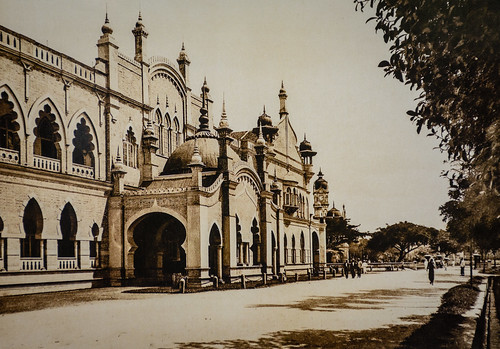 |
| The Municipal Office & Town Hall c. 1906 |
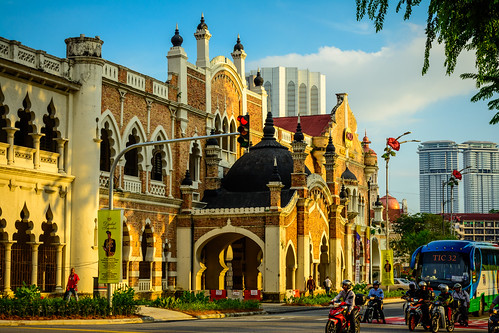 |
| The former Municipal Office & Town Hall at present. |
The Municipal Offices were completed more than one month later though. In the Annual Report FMS Selangor 1904 it was stated that The new Municipal Offices in Kuala Lumpur, adjoining to the Town Hall, were occupied by the Sanitary Board staff on 27 October 1904. They were reported to be in every way suitable for the purpose for which they were designed.
Kuala Lumpur Sanitary Board was set up in 1890 whose members included heads of state departments, such as Medical, Public Works and Police, and also two Malay and two Chinese members of the State Council, men of influence. This was the first municipal body in any Malay state and became the general model. The Board first occupied a shophouse in Ampang Road at its office and in 1894 moved to another shophouse but bigger located at 137, Batu Road (now Jalan Tuanku Abdul Rahman) before it eventually was relocated to a proper office in its own building, The Municipal Office & Town Hall in 1904 as stated above.
The Malay Mail dated 2 December 1904 heaped praise on this elegant Indo-Saracenic edifice which was the second structure in that style after the Sultan Abdul Samad Building. The Malay Mail stated as follows:
This block of buildings supplies long-felt wants, for not only does it give us a hall in which dances and other entertainment can be held on a scale previously denied to us, but it enables the Sanitary Board to at length take up quarters befitting its important role in our town. In addition to these advantages, the building forms a fitting adjunct to the fine public offices close by and is a decided ornament to the town.The Malay Mail added:
For this we are indebted to Mr A.B.Hubback, the State Architect, who furnished the plan, and Mr. Nicholas, who in carrying the work through to a successful completion in spite of adverse circumstances, has set up yet another monument in our midst which does credit both to himself and to the town of which he is a member.
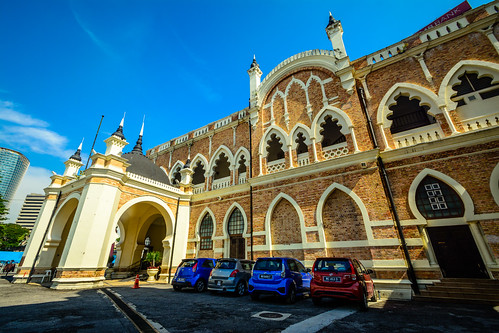 |
| The former Municipal Office and Town Hall - its entrance that fronts Gombak River. |
With the completion of this building it was another achievement for the engineering team led by the State Engineer, CE Spooner, and the prolific architect, AB Hubback after their success in completing the Sultan Abdul Samad Building in 1897.
This building strongly features Indo-Saracenic architectural style such as their prominent bulbous domes that topped both porte cochère at its each entrance. While its arcade is adorned with pointed horse shoe arches and scallop arches. There is also an overhanging balcony which is a typical Mughal architectural feature from which Indo-Saracenic architecture resulted.
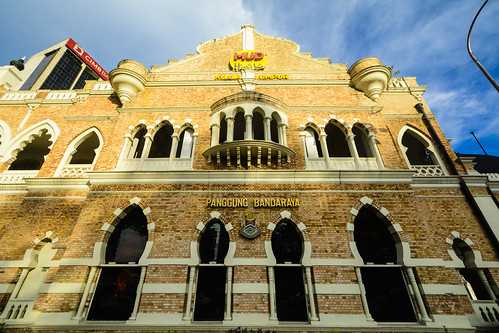 |
| Jarokha - An overhanging window/balcony |
This historic building has been standing strong for close to 113 years. Until now it still serves as the City Theatre or Panggung Bandaraya in Malay where various plays and musicals are staged here.
However what still remains are only the outer structure and the façade after a major fire entirely destroyed the interior of both the former City Hall office and the City Theatre (Panggung Bandaraya in Malay) on 16 March 1992. The fire was reported to have spread fast because of the plywood and softboard ceilings and the lack of modern fire-fighting equipment in the building. But soon after, the City Hall's designers and builders have restored its interior by refurbishing it and incorporating significant modifications to the furnishings and the sound system.
The building is now known as Panggung Bandaraya (Malay for City Theatre) and is gazetted as a heritage building under the Antiquities Act (It is now replaced with National Heritage Act 2005), while its Mughal-eclectic/Indo-Saracenic façade has been preserved.
REFERENCE
Gullick, J.M. (2000). A history of Kuala Lumpur 1857-1939. Kuala Lumpur: MBRAS.
Mathews, P. (2014). Chronicle of Malaysia: Fifty years of headline news, 1963-2013. Singapore: Editions Didier Millet.
Our municipal offices and town hall. (1904, December 2). The Malay Mail.
Sir William Treacher. Grand farewell ball at Kuala Lumpur. (1904, September 10). The Straits Times, p.5.
Good This is very unique informative and beautiful article. I like it very much thanks
ReplyDeletetarpaulin uk
Thank you for dropping by and leaving your comment. Malaysia has various types of heritage buildings especially in its major towns left behind by the British Colonial Government. At that time Malaya (now Malaysia) was one of the darling protectorates as there was abundant natural resources like tin and rubber.
Delete